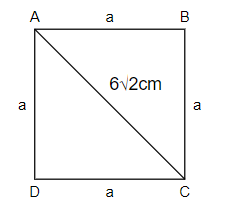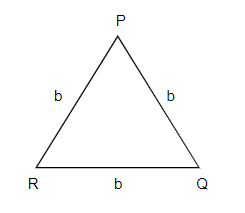Answer
417k+ views
Hint: First consider the square of side $a$ and find its value by using the Pythagoras theorem. Now equate its perimeter to that of the equilateral triangle. Use the formula $\dfrac{\sqrt{3}}{4}{{\left( side\text{ }of\text{ }triangle \right)}^{2}}$ to get the area of the equilateral triangle.
Complete step-by-step answer:
We have been given a square and an equilateral triangle of equal perimeters. The diagonal of the square is given as $6\sqrt{2}cm$. We have to find the area of the triangle. Let us consider the square of side $a$.

We have been given that the length of the diagonal of this square is $6\sqrt{2}cm$. We know that each angle of a square is the right angle. So, we can apply Pythagoras theorem in triangle $ABC$, and we get, ${{\left( AB \right)}^{2}}+{{\left( BC \right)}^{2}}={{\left( AC \right)}^{2}}$ .
By substituting the values of $AB=BC=a$ and the value of $AC=6\sqrt{2}$, we get,
$\begin{align}
& {{a}^{2}}+{{a}^{2}}={{\left( 6\sqrt{2} \right)}^{2}} \\
& \Rightarrow 2{{a}^{2}}=72\Rightarrow {{a}^{2}}=\dfrac{72}{2}=36 \\
\end{align}$
So, we get $a=\sqrt{36}=6cm$. We know that the perimeter of any polygon is equal to the sum of the length of its sides. So, we get, perimeter of square ${{P}_{S}}=4\left( length\text{ }of\text{ }side \right)\Rightarrow {{P}_{S}}=4a$. By substituting the value of $a=6$ , we get, ${{P}_{S}}=4\times 6=24cm\ldots \ldots \ldots \left( i \right)$.
Now, let us consider an equilateral triangle of sides $b$.

We know that the perimeter of a triangle ${{P}_{T}}=3\left( length\text{ }of\text{ }side \right)\Rightarrow {{P}_{T}}=3b\ldots \ldots \ldots \left( ii \right)$.
We have been given that the perimeter of the square is equal to the perimeter of the equilateral triangle, so we get, ${{P}_{S}}={{P}_{T}}$.
By substituting values of ${{P}_{S}},{{P}_{T}}$ from equation (i) and (ii) in the above equation, we get, $24=3b$. By dividing both the sides by 3, we get, $b=\dfrac{24}{3}\Rightarrow b=8cm$. So, we get the length of the side of the equilateral triangle as $8cm$.
Now, we know that the area of the equilateral triangle is $\dfrac{\sqrt{3}}{4}{{\left( side \right)}^{2}}$. So, we get the area of the given equilateral triangle $=\dfrac{\sqrt{3}}{4}{{\left( b \right)}^{2}}=\dfrac{\sqrt{3}}{4}{{\left( 8 \right)}^{2}}=16\sqrt{3}c{{m}^{2}}$. So, the area of the triangle is $16\sqrt{3}c{{m}^{2}}$. Hence option B is the correct answer.
Note: In this question, many students make mistakes by assuming the length of the sides of the square and triangle are the same, which is wrong because then the perimeter will not be equal, which is already mentioned in the question. It is better to remember the area of equilateral triangle as $\dfrac{\sqrt{3}}{4}{{\left( side\text{ }of\text{ }triangle \right)}^{2}}$ instead of $\dfrac{1}{2}\times base\times height$ as it makes it easy to solve the question.
Complete step-by-step answer:
We have been given a square and an equilateral triangle of equal perimeters. The diagonal of the square is given as $6\sqrt{2}cm$. We have to find the area of the triangle. Let us consider the square of side $a$.

We have been given that the length of the diagonal of this square is $6\sqrt{2}cm$. We know that each angle of a square is the right angle. So, we can apply Pythagoras theorem in triangle $ABC$, and we get, ${{\left( AB \right)}^{2}}+{{\left( BC \right)}^{2}}={{\left( AC \right)}^{2}}$ .
By substituting the values of $AB=BC=a$ and the value of $AC=6\sqrt{2}$, we get,
$\begin{align}
& {{a}^{2}}+{{a}^{2}}={{\left( 6\sqrt{2} \right)}^{2}} \\
& \Rightarrow 2{{a}^{2}}=72\Rightarrow {{a}^{2}}=\dfrac{72}{2}=36 \\
\end{align}$
So, we get $a=\sqrt{36}=6cm$. We know that the perimeter of any polygon is equal to the sum of the length of its sides. So, we get, perimeter of square ${{P}_{S}}=4\left( length\text{ }of\text{ }side \right)\Rightarrow {{P}_{S}}=4a$. By substituting the value of $a=6$ , we get, ${{P}_{S}}=4\times 6=24cm\ldots \ldots \ldots \left( i \right)$.
Now, let us consider an equilateral triangle of sides $b$.

We know that the perimeter of a triangle ${{P}_{T}}=3\left( length\text{ }of\text{ }side \right)\Rightarrow {{P}_{T}}=3b\ldots \ldots \ldots \left( ii \right)$.
We have been given that the perimeter of the square is equal to the perimeter of the equilateral triangle, so we get, ${{P}_{S}}={{P}_{T}}$.
By substituting values of ${{P}_{S}},{{P}_{T}}$ from equation (i) and (ii) in the above equation, we get, $24=3b$. By dividing both the sides by 3, we get, $b=\dfrac{24}{3}\Rightarrow b=8cm$. So, we get the length of the side of the equilateral triangle as $8cm$.
Now, we know that the area of the equilateral triangle is $\dfrac{\sqrt{3}}{4}{{\left( side \right)}^{2}}$. So, we get the area of the given equilateral triangle $=\dfrac{\sqrt{3}}{4}{{\left( b \right)}^{2}}=\dfrac{\sqrt{3}}{4}{{\left( 8 \right)}^{2}}=16\sqrt{3}c{{m}^{2}}$. So, the area of the triangle is $16\sqrt{3}c{{m}^{2}}$. Hence option B is the correct answer.
Note: In this question, many students make mistakes by assuming the length of the sides of the square and triangle are the same, which is wrong because then the perimeter will not be equal, which is already mentioned in the question. It is better to remember the area of equilateral triangle as $\dfrac{\sqrt{3}}{4}{{\left( side\text{ }of\text{ }triangle \right)}^{2}}$ instead of $\dfrac{1}{2}\times base\times height$ as it makes it easy to solve the question.
Recently Updated Pages
Three beakers labelled as A B and C each containing 25 mL of water were taken A small amount of NaOH anhydrous CuSO4 and NaCl were added to the beakers A B and C respectively It was observed that there was an increase in the temperature of the solutions contained in beakers A and B whereas in case of beaker C the temperature of the solution falls Which one of the following statements isarecorrect i In beakers A and B exothermic process has occurred ii In beakers A and B endothermic process has occurred iii In beaker C exothermic process has occurred iv In beaker C endothermic process has occurred

The branch of science which deals with nature and natural class 10 physics CBSE

The Equation xxx + 2 is Satisfied when x is Equal to Class 10 Maths

Define absolute refractive index of a medium

Find out what do the algal bloom and redtides sign class 10 biology CBSE

Prove that the function fleft x right xn is continuous class 12 maths CBSE

Trending doubts
State the differences between manure and fertilize class 8 biology CBSE

Why are xylem and phloem called complex tissues aBoth class 11 biology CBSE

Difference between Prokaryotic cell and Eukaryotic class 11 biology CBSE

Difference Between Plant Cell and Animal Cell

What would happen if plasma membrane ruptures or breaks class 11 biology CBSE

Give 10 examples for herbs , shrubs , climbers , creepers

What precautions do you take while observing the nucleus class 11 biology CBSE

What would happen to the life of a cell if there was class 11 biology CBSE

Change the following sentences into negative and interrogative class 10 english CBSE



